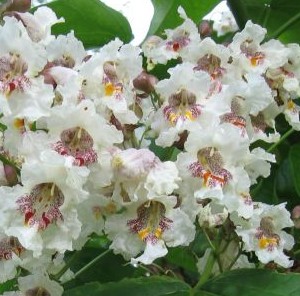 Also called cigar tree, this native of southeastern United States is a deciduous tree with a thick short trunk and pithy, brittle branches that are prone to wind damage. The heart-shaped leaves are up to ten inches long and have an unpleasant odor when crushed. They are purple as they unfurl but turn bright green as they mature. In late spring to early summer, the flowers are produced in upright pyramidal panicles eight to ten inches long and composed of twenty to forty flowers. Each flower is white with purple and yellow spots, and has frilly edges. In autumn the flowers are followed by thin, dark brown bean-like seed pods up to eighteen inches long by ½ inch wide that persist into winter. Each pod contains numerous silver gray seeds that have wings on either side and bear hairs on the ends. To maintain a small size trees are often cut back to a stump in late winter and the resulting shoots thinned to one to three but this procedure will eliminate flowers.
Also called cigar tree, this native of southeastern United States is a deciduous tree with a thick short trunk and pithy, brittle branches that are prone to wind damage. The heart-shaped leaves are up to ten inches long and have an unpleasant odor when crushed. They are purple as they unfurl but turn bright green as they mature. In late spring to early summer, the flowers are produced in upright pyramidal panicles eight to ten inches long and composed of twenty to forty flowers. Each flower is white with purple and yellow spots, and has frilly edges. In autumn the flowers are followed by thin, dark brown bean-like seed pods up to eighteen inches long by ½ inch wide that persist into winter. Each pod contains numerous silver gray seeds that have wings on either side and bear hairs on the ends. To maintain a small size trees are often cut back to a stump in late winter and the resulting shoots thinned to one to three but this procedure will eliminate flowers.
Type: Deciduous flowering tree
Outstanding Feature: Flowers; specimen tree
Form: Umbrella shaped
Growth Rate: Rapid
Bloom: Pyramidal clusters eight to ten inches long of 10-40 white flowers with purple and yellow spots in late spring to early summer
Size:25-40’H x 25-40’ W but can be cut back to maintain small size
Light: Full sun
Soil:Average, moist, well-drained
Hardiness: Zones 5-9
Care: Can cut back to a stump in late winter, thin resulting branches to one to three
Pests and Diseases: None of significance
Propagation: Seed in autumn; softwood cuttings in gritty compost in summer; root cuttings in early winter
Outstanding Selections:
-
C. bignonioides ‘Aurea’ (Gold leaf; smaller than species)
C. × erubescens ‘Purpurea’ (Purple leaf)
